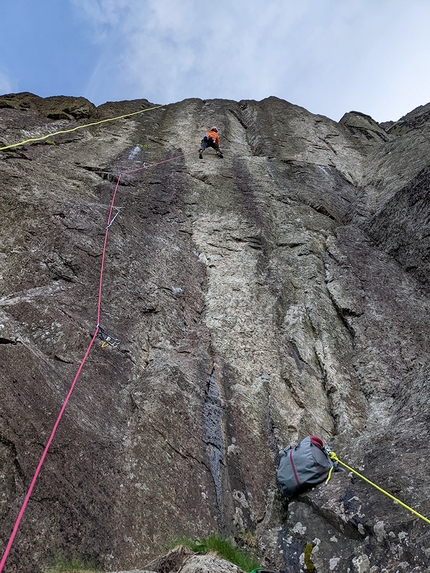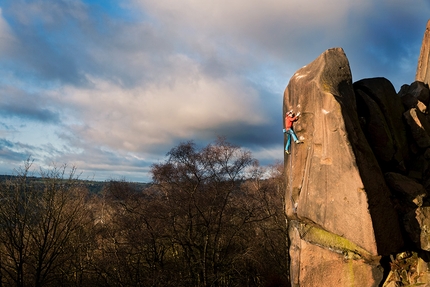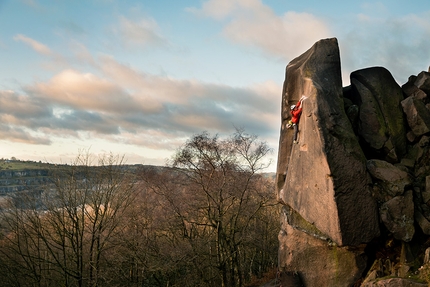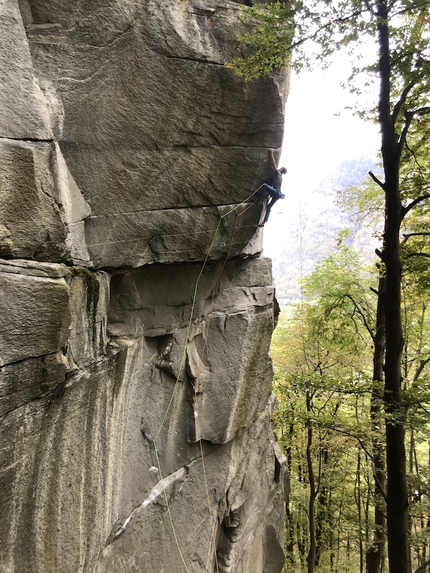James Pearson frees Bon Voyage, new trad gem at Annot in France

 1 / 5
1 / 5 Raphaël Fourau
Raphaël Fourau
After putting in a concerted 20-day effort spread out over the last two years, British rock climber James Pearson has made the first ascent of his long-standing trad project in Annot, France. The trad climb shares the same start as Le Voyage, an E10 he first ascended in 2017, before trending out to the left across the imposing blank face via a series of shallow pockets, and finishing up a technical arête. At times runout, the route appears to fit in the "hard but safe" category of trad climbs.
The new route is called Bon Voyage and although a grade has yet to be put forward, the line almost certainly sits amongst some of the world’s hardest trad climbs, having taken Pearson significantly more time than any of his previous first ascents or repeats. These include the ungraded Tribe at Cadarese, Italy and Lexicon (E11 7a) at Pavey Ark, Langdale, UK.
Pearson, who as per usual placed all gear on lead, explained "I found the line in 2021 and have been actively preparing myself for it since then. It felt like quite a step up from other hard trad routes I’ve tried over the years, but I’ve really enjoyed the process of developing new skills and strengths to be able to stand a chance.
After the split with Le Voyage, a first boulder problem takes you to a couple of good pockets (the final protection of the route) and a marginal rest. From here there are 20 hard moves to the finishing ledge, almost exclusively on shallow pockets and tiny crimps. The route is definitely run out, with long falls, but you’d be unlucky to hurt yourself providing the protection is well placed. Annot has some of the blankest rock I have ever seen and the walls can often be sandy and loose, meaning most of the routes stick to crack systems. Bon Voyage follows a diagonal layer of bullet hard sandstone dotted with tiny pockets... a true miracle of Mother Nature and a reminder why all the years of searching were worth it."
The 37-year-old continued "It’s 15 years since The Walk of Life. I admit I’m still struggling to separate myself from my past. The idea of giving a grade to Bon Voyage and getting it ‘wrong’ makes me uneasy to say the least. I’ll try to focus on facts: this route took me longer than any other route or boulder I’ve ever tried. Both in terms of days actively trying it and time preparing myself for it (~ 20 days over 2 years and 10 redpoints). I spent more actual redpoint attempts on this than on Tribe, and all of my other 9a sport routes. I had to train specifically on a fingerboard to be able to do the moves and link the intense, fingery crux section. Around the same time I made the first ascent, I climbed a couple of 9a's in a similar length and style. These took me around 4 sessions and 4 to 5 redpoints. These sport routes are both slightly more overhanging with easier moves but worse rests, and shouldn’t suit me as well.
But I’m also aware that: it’s a First Ascent, and they always feel harder than a repeat. Of the 20 days, at least 4 of them were spent brushing holds and trying to understand if the line might be possible. It’s slightly off-vertical which is a really difficult angle to grade. The holds are so very small and poor, that the moves feel difficult at first, but can quickly feel much easier as you learn the subtleties of each position. The route is on pockets, which I believe to be one of my weaknesses. However, the pockets are so shallow (less than half pad) that they are more like crimps (my strength), and because of the sides of the pocket, you can’t use your thumb so you are forced to half crimp (my strongest grip type). It leaves me questioning: Did I need to train specifically just to reach an average level, or did I train to make my best strength even stronger? The answer to this question changes everything.
The crux move is very low percentage. I fell many times on this move before passing it - counting significantly towards my number of redpoints, but with a bit more luck I might have passed it sooner. Still, even after passing it I still fell 3 times in the 2nd to last boulder, and almost fell on the final technical arête! It’s definitely not a one move wonder.
At the moment I don’t feel able to give this route a definite grade, which always sounds funny to me as a grade proposal should be just that, a proposal. In theory I should simply say what I think, leaving future repeater’s to give their opinion, and eventually we settle on a consensus. Perhaps I’m more sensitive than the average person but in practice I’ve seen and felt that it doesn’t quite work like that.
I could go with my gut and remind myself that at 37 I’m really too old to worry about things like this. I could also under grade it, effectively downgrading it myself before anyone else gets the chance, but this has a tendency to lead to grade stagnation like we’ve got with trad routes in the UK, and doesn’t do anyone any favours. However, both of these options would rely on me having a fixed grade in my head, which for all the above reasons - I simply don’t, yet. Before offering a grade I’d like to try a few more hard sport routes to better gauge my level, and also climb at Annot with other high-level climbers. Hopefully this will give me a better idea."
Eternal grade debates aside, planetmountain asked Pearson what this climb meant to him. The Englishman responded frankly "I feel like it’s a lovely route and I'd be happy if it turned out to be my last hard first ascent. I am not saying I am never going to look for a new line again, but I feel like having climbed this one I can relax."
Link: La Sportiva, The North Face



 Copia link
Copia link




























